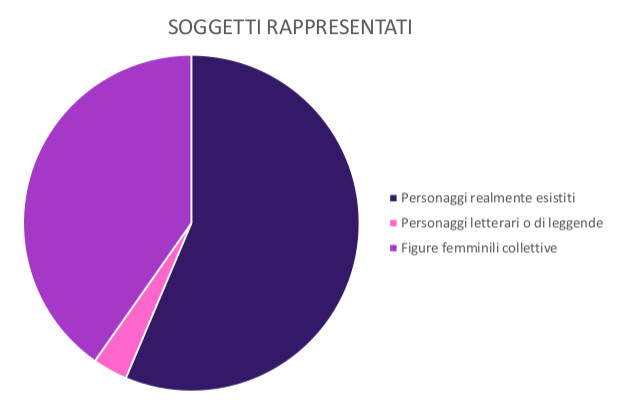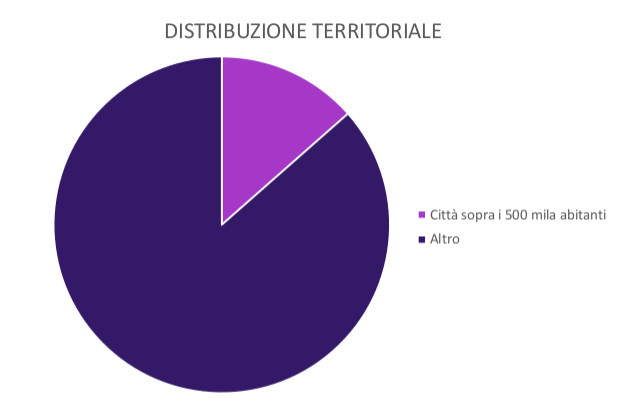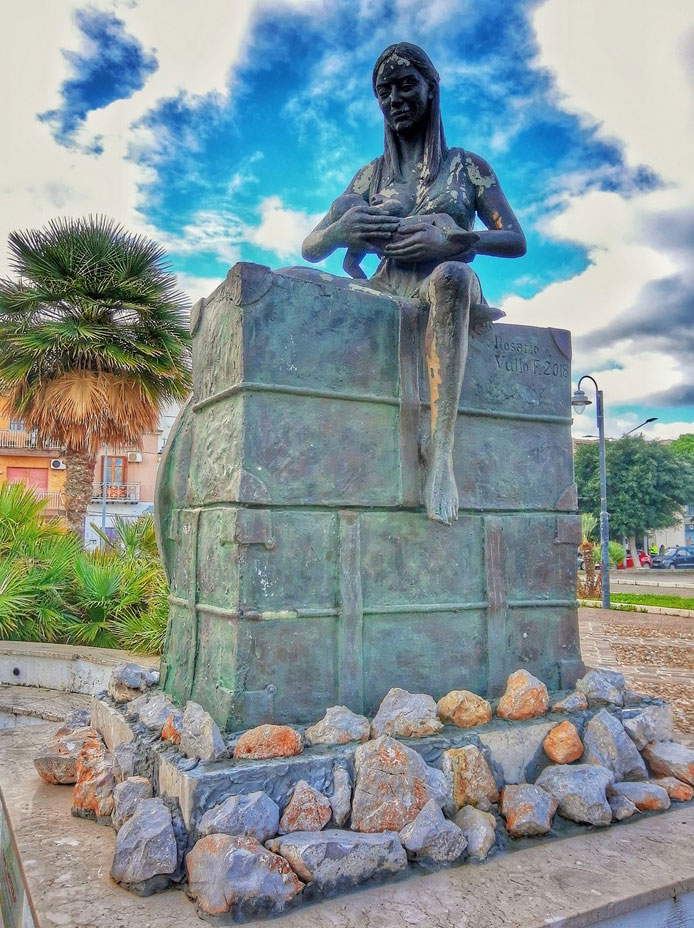How many women’s monuments are there in Italy? And are they adequate to give shape to what they want to represent? These are the assumptions behind the first survey of public female statuary in Italy, conducted by the association Mi Riconosci between September 25 and October 13, 2021. The association, which has always been active in the field of cultural heritage, surveyed a total of 148 monuments featuring women as protagonists, scattered throughout Italy. A number that, according to the association, approaches the totality of those in existence, the promoters explain. The data were collected through the reports arrived through the questionnaire Survey of Women’s Public Monuments, promoted by the association by asking its audience (estimated at 42 thousand people) to report monuments in their city. These data were then supplemented by the personal knowledge and research of the promoting activists, research on Wikimedia structured data, and detailed perusal of the sites dedicated to monuments Who Was This One? and Statues - Hither and Thither.
Those of real-life women, those of literary figures, and those of anonymous collective figures (e.g., wife, partisan, mondina, to name but a few examples) found in public spaces such as squares, gardens, and streets were considered for the survey. Excluded were allegorical figures such as “the Fatherland” or “Victory,” or monuments to the Virgin Mary, or even statues found in private and public courtyards (including those of schools and hospitals) and cemeteries. The initiative gained momentum after the recent cases of the monuments to Cristina Trivulzio di Belgiojoso (Milan) and to the Spigolatrice (Sapri), as Ludovica Piazzi, art historian and promoter of the survey, explains, “After the inauguration of the two monuments, we asked ourselves how women are represented when there is a place for them in public space. The data we got is not comforting.”


In major Italian cities, monuments dedicated to women are almost absent: putting together Rome, Naples, Milan, Turin, Florence, Bologna, Bari, Palermo, Cagliari and Venice, we arrive at a total of 20, of which only 8 are true figured monuments. Of the 148 monuments and statues surveyed, only 36 percent are located in a square; the remainder are at intersections or roadsides, as well as in parks. Of these 148 works, 14 percent are busts, 4 percent are fountains, and 2 percent are groups that also feature men or children.
From the data it can be deduced that very few women are remembered for merits that do not include sacrifice or care. There are very few monuments dedicated to women who actually lived in Italy: Grazia Deledda, Maria Montessori, Sister Maria De Mattias, missing figures such as Elsa Morante or Ada Rossi, Gaetana Agnesi or Trotula de Ruggiero. Out of 148 works surveyed, as many as 60 are anonymous collective figures: of these, 12.5 percent represent partisans, while 70 percent represent particularly physically strenuous professions, such as mondine or laundresses. No monuments commemorate, for example, midwives, clerks or female scientists.
Public space, the promoters explain, cannot be considered neutral: it always reflects the institutions that place the statues, even if they are donations. And to date, according to Mi Riconosci, it is an androcentric space, as confirmed not only by the absence of women, but also by the huge disproportion between authors and authors of the female monuments surveyed. 120 works out of 148, in fact, have a certain attribution, and of these only 5 percent were made by women, 5 percent see collaboration between authors and female authors, while the remaining 90 percent are signed only by men.
The promoters also point out the tendency to represent the female figure in a stereotypical way: in fact, many statues have sensual attitudes or are marked by prissy details, aspects that inevitably detract from the portrayed subject. Also recurring is the presence of children emphasizing the role of care, as if to justify the presence of a statue of a female subject in public space. “Our goal is not to focus attention on an absence that needs to be filled,” Ludovica Piazzi concludes, “but to provoke reflection on what appears to us on view: statues that in most cases have only the subject as female. We note the sharp increase in recent years of statues dedicated to real women and collective female figures, but are these works really going to rebalance the female presence in public space?”
The association, which will continue to collect reports, explains that these initial findings will be reworked and analyzed in the coming weeks, with the publication on the website www.miriconosci.it of an interactive map showing all the female monuments in Italy, and a series of debates on the subject. “We cannot continue to ignore the problem, public space and monuments shape our way of thinking, offer models, remember and celebrate: that is why an analytical and feminist approach is necessary,” the activists conclude.



We asked activists what are the best examples of women’s monuments that exist in Italy. Several significant monuments were identified: we can start with Whistles the Wind the monument to the partisan women inaugurated in Milan in April 2021: it is an aniconic representation, because the protagonist of the monument is the sound produced by metal reeds moved by the wind. It is at the same time a collective and individual monument, since each cane is engraved with the battle name of a partisan woman, and it avoids the representation of the classic collective and suffering female figure, evoking anxieties and hopes of that historical moment with great delicacy, and prompting the observer to delve into the history of the individual protagonists. Again, Andando via, a monument to Grazia Deledda erected in Nuoro in 2011: the author, Maria Lai (Ulassai, 1919 - Cardedu, 2013), one of the most important artists of the twentieth century, describes with essential lines some female characters from the works of Grazia Deledda in the land that gave them both their birth. “Significant for us,” the activists declare, “because it is one of the rare examples in Italy in which author and subject represented are both women; it is also a non-figurative work that pays homage to a character through the narration of her work, rather than by depicting her person. It has recently been reproduced in tapestries to commemorate both women artists, carrying on a Sardinian and female tradition that connotes Lai’s work.”
Then we can mention La Zigherana, from 2012, a figurative monument erected at the Manifattura Tabacchi in Borgo Sacco (Rovereto): “in our opinion,” explain the promoters of the survey, “it pays homage to the female tobacco workers by recounting with dignity and respect their work, the packaging of cigars. There are no prissy details or elements that connote the worker as even a mother or wife, and the monument is effectively placed in the context of the industrial history of the place.” Continuing, the monument to Queen Helena of Savoy in Messina, erected to honor her for her work after the earthquake that destroyed the city in 1908, unveiled in 1960, is significant “for its monumentality (rarely granted to a female character),” the activists explain, “and for its symmetrical posture, which communicate authoritativeness and calmness, rare characteristics if we compare it, for example, with the public statues dedicated to Elizabeth of Bavaria in Italy. We also appreciate it because it was made at the request of the citizenry.” Finally to be mentioned is the first monument to the Spigolatrice of Sapri, as opposed to the one inaugurated last September 25 and the subject of controversy due to unnecessary transparency and winking gaze of the woman represented, which divert attention from the original reason for which the statue was erected.





The promoters of the survey also identified some questionable monuments, all made after 2000. Among the worst monuments is the one to the journalists Ilaria Alpi and Maria Grazia Cutuli, erected in Acquapendente in 2003: “we did not like it,” they explain, “because since it is not an allegorical representation of two nymphs but of two professional journalists who died on the job, nudity is an unnecessary element; we wondered if two journalists would have been represented in the same way, ending up finding it a monument disrespectful of the professionalism and memory of the two journalists.” Another monument that wrinkles the nose is the one to Francesco Crispi and Rose Montmasson, unveiled in 2011 in Ribera, where an asymmetry between the two figures is evident, with him seated, in an authoritative, elevated and hieratic pose, and her, the only woman to have taken part in the Expedition of the Thousand, a repudiated ex-wife, lacking any resemblance to her real-life self, portrayed in petticoats, on a lower plane and while handing an hourglass to her ex-husband, as a sort of valet (her name, moreover, is not in the inscription). Among the worst monuments is also that of the washerwoman in Via della Grada, present in Bologna since 2000: among the many monuments to washerwomen in Italy, the activists say, “this one detects in our opinion for the pose more than for the nudity, and for the fact that the original intention of the author (to pay homage to the category of washerwomen) in fact does not emerge, as there is no explanation of why this depiction is made; it ends up being yet another unnecessary nude offered to the distracted passerby.”
Then there is the Monument to the Emigrant, from 2018 in Isola delle Femmine, chosen because again nudity is not a necessary element for understanding the meaning of the monument: other stereotypes of female depiction also emerge, such as young age, almost provocative pose, and the moment of breastfeeding. Finally, the Water Woman monument, in Bari since 2003, “struck us,” conclude the survey promoters, “not so much because of the type of depiction adopted, but because of the inscription placed under the statue; while we believe, if contextualized, that the references to the ’pains of loneliness’ and ’terror for the evils of the world’ (feelings not alien to fishermen’s families) are understandable, we find incomprehensible, today, the passages in which the water-woman becomes ’symbol of the universal woman,’ or is referred to, in sequence, as the guardian bride of the hearth, loving ’mater’ and sorrowful ’mater. A narrative perhaps not in line with our current events.”




 |
| Few and stereotyped: women in monuments in Italy, from washerwoman to gleaner |
Warning: the translation into English of the original Italian article was created using automatic tools. We undertake to review all articles, but we do not guarantee the total absence of inaccuracies in the translation due to the program. You can find the original by clicking on the ITA button. If you find any mistake,please contact us.